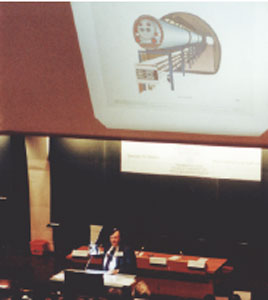
It was a workshop on a scale to match the ultimate goal. When some 500 physicists met in Aachen, Germany, in October to put the research case for the proposed Large Hadron Collider (LHC) at CERN, the turnout was among the biggest attendances of the year.
Organized by ECFA, the European Committee for Future Accelerators, the meeting, by its attendance and by the depth of its scientific content, clearly displayed the enthusiasm for LHC in the research community, and provided valuable additional impetus for the already-compelling idea of a proton collider using superconducting magnets in the 27 km tunnel built for LEP.
Introducing the plenary sessions at Aachen, CERN director-general Carlo Rubbia underlined the complementarity of a dual LEP–LHC complex with its electron and proton beams, providing a balanced two-pronged attack on the physics-research frontier while at the same time making the most of CERN’s versatile beam-handling systems, both existing and potential. With CERN already serving a varied menu of particles, LHC physics would be well-endowed with beam options. As well as providing proton–proton collisions at about 8 TeV per beam, LHC could follow the tradition of CERN’s other proton machines and handle heavy ions as well.
With basic (dimensional) arguments saying that reaction rates have to decrease with collision energy, then high luminosity (related to the collision rate) is a basic collider requirement which is expected to become even more important at higher energies. Thus a main aim of the LHC design is to attain the highest-possible luminosities.
The Aachen meeting mirrored on one hand the physics potential opened up by such a high-luminosity approach, and on the other the challenges for the detector systems which will have to handle bunches of 1011 protons crossing every 15 ns or so, resulting in billions of secondary particles each second. In addition to coping with this flood of data, the potentially delicate detector components will have to withstand long exposure to this harsh radiation environment.
The presentations at Aachen summarized the work of the hundreds of physicists in LHC working groups set up by ECFA earlier this year. Three groups looked at the physics potential of the three collision options (proton–proton, electron–proton, and ion–ion), while others studied detector aspects.
For proton–proton collision physics, Daniel Denegri of Saclay looked at the implications of the current Standard Model, while Felicitas Pauss of CERN attempted to look at the uncharted territory beyond. Putting the physics case for LHC proton–proton studies, Guido Altarelli of CERN was confident that new physics would turn up at the mass scales covered by this machine and provide a natural explanation for some of the apparently arbitrary numbers of today’s Standard Model (the unification of the weak nuclear force and electromagnetism loosely tied to the quark–gluon field theory of strong nuclear forces). While no cracks have yet appeared in this structure, Altarelli thought that with LHC the betting would be against the Standard Model, and its continued survival would be a turnup for the book.
Major goals include the clarification of the electroweak symmetry breaking mechanism (Higgs Particle), where Altarelli remarked there was room for contributions from LEP a well as from the proton–proton sector. However with its proposed high luminosity of 1034/cm2 per s, LHC has the discovery potential to attack the main outstanding questions of particle physics. Subsequent talks outlined the additional potential opened up by LHC’s electron–proton and ion–ion collision options.
Summarizing the work on the interaction regions where LHC experiments would be housed, Lars Leistam of CERN pointed out that if construction work on big new underground caverns is to begin in 1993, then the plans for the experimental areas should be ready by the end of next year. Although ideas for individual experiments have not yet been tabled, the sessions on muon identification at least gave some idea of what an LHC detector might look like. Contenders included toroids, solenoids, and their variants, and an idea to convert the L3 setup currently used at LEP.
• December 1990 pp3–5 (abridged).
“The LHC project now exists”
Sir William Mitchell
1991: The right machine
At the December meeting of CERN’s Council, the Organization’s Governing Body, the delegates from the 16 member states unanimously agreed that the LHC proton–proton collider proposed for the 27 km LEP tunnel is the ‘right machine for the advance of the subject and of the future of CERN’. Detailed information on costs, technical feasibility and prospective delivery schedules, and involvement of CERN Member States and other countries, together with an outline of the LHC experimental programme, its goals and its implications, including funding, will be provided before the end of 1993 so that Council can move towards an LHC decision. Following the vote, Council President Sir William Mitchell said “this is a historic occasion”. “The LHC project now exists,” he added.
The vote followed a special extended Council session on the LHC project on 19 December before extended delegations from CERN Member States and invited guests from other nations. They heard presentations from Scientific Policy Committee chairman Chris Llewellyn Smith on the physics potential for LHC, from ECFA Chairman J-E Augustin on the LHC user aspects, and from CERN director-general Carlo Rubbia on the LHC project and the future of CERN. This special meeting helped prepare the ground for Council’s vote the following day.
• January/February 1992 pp23–24 (extract).








